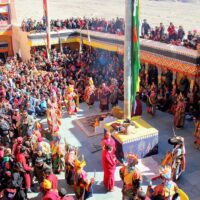
Location: Thiksey Monastery, Ladakh Dates: November 18th – 19th, 2024 Festival Overview: Every year, the Thiksey Gustor Festival takes place in the 9th month of the Tibetan lunar calendar, specifically on the 17th, 18th, and 19th days. This event is deeply rooted in the Gelukpa tradition of Tibetan Buddhism and is hosted by Thiksey Monastery. Highlights: Vibrant Mask Dances: Monks donning elaborate silk robes and masks depicting various deities perform traditional dances, creating a mesmerizing spectacle. Intricate Sand Mandalas: Skilled monks craft sand mandalas representing Guyusamaja, Chakrasamvara, and Vajravairava deities. These intricate designs, made from millions of grains of colored sand, symbolize the divine abodes and serve as meditation aids. […]
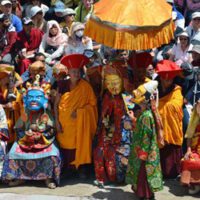
Location: Diskit Monastery, Nubra Valley Dates: From October 30, 2024 To October 31, 2024 Immerse Yourself in the Deskit Gustor Festival Nestled in the scenic Nubra Valley, Diskit Monastery stands as a testament to the rich tapestry of Tibetan Buddhism. Founded by the venerable Changzem Tserab Zangpo, a direct disciple of Tsong-kha-pa, this monastery is both the largest and oldest in the region. Perched majestically on a hilltop, it commands a panoramic view of the valley and the Shayok River below. As a key site of the Gelugpa (Yellow Hat) sect, it is renowned not only for its historical significance but also for the vibrant celebration of the Deskit Gustor […]
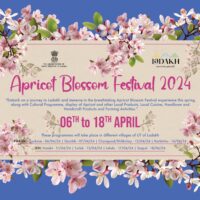
Location Highlights: Kargil: Garkone, Darchik, Chanigond/Shilikchay, Karkichu Leh: Hundri, Turtuk, Lehdo, Saspol Event Overview: The Ladakh Tourism Department proudly presents the Apricot Blossom Festival, a vibrant celebration of local heritage, inviting visitors to immerse themselves in the region’s rich culture. Spanning from April 6 to April 18, 2024, this festival transforms the serene landscapes of Leh and Kargil into hubs of festivity. Throughout these dates, various locations in the valley will host day-long events where attendees can enjoy an array of activities. From lively cultural performances and traditional music to bustling markets and engaging games, there’s something for everyone. Witness the apricot trees in full bloom and explore the unique […]
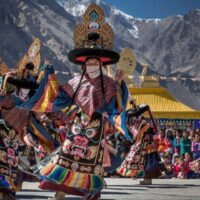
Célébration : Festival de Leh Ladakh 2024 Le mois de septembre à Leh accueille une célébration vibrante de quatre jours, connue sous le nom de Festival de Leh Ladakh. Cet événement annuel, organisé par le département du tourisme, met en lumière le riche patrimoine culturel des diverses communautés et tribus du Ladakh. Les visiteurs peuvent profiter de danses et chants folkloriques traditionnels, de sports locaux palpitants comme le polo et le tir à l’arc, ainsi que d’expositions présentant des thangkas et de l’artisanat. Les danses monastiques, un festival culinaire et des dégustations de Chang local (alcool) viennent enrichir l’ambiance festive. La période du festival coïncide avec la saison des récoltes, […]
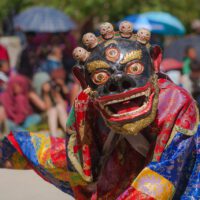
Where: Sani Monastery, Kargil When: 20 – 21 July 2024 Entry: Free Discover the Magic of Sani Nasjal Celebrate the enchanting Sani Nasjal festival at the historic Sani Monastery in Zanskar, Ladakh. This event takes place when the Guru Naropa Flower blooms, usually during the first week of August, but this year it will be held in July. The festivities are deeply rooted in tradition and spirituality, centered around the revered figure of Naropa, a prominent Indian yogi from the 10th-11th century. Event Highlights: Unveiling of the Naropa Statue: Witness the grand reveal of Naropa’s statue, a key moment of the festival. Mask Dances by Lamas: Enjoy the captivating mask […]
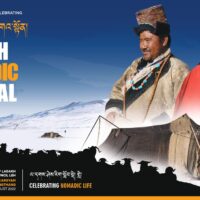
Festival Nomade : Organisé par l’Académie Culturelle du Ladakh et soutenu par le Département du Tourisme du Ladakh, ce festival vise à mettre en valeur la culture unique de la région du Changthang, en la plaçant fermement sur la carte touristique du Ladakh. Les visiteurs ont eu l’opportunité de s’immerger dans le mode de vie nomade authentique du peuple du Changthang, connu sous le nom de « Changpa » ou « Drokpa » en tibétain, signifiant respectivement « gens du nord » et « nomades ». Contrairement à d’autres communautés nomades, les Changpa prospèrent dans des paysages hostiles et inhabitables, inadaptés à l’agriculture, à l’abri de l’empiètement des agriculteurs sédentaires. […]

